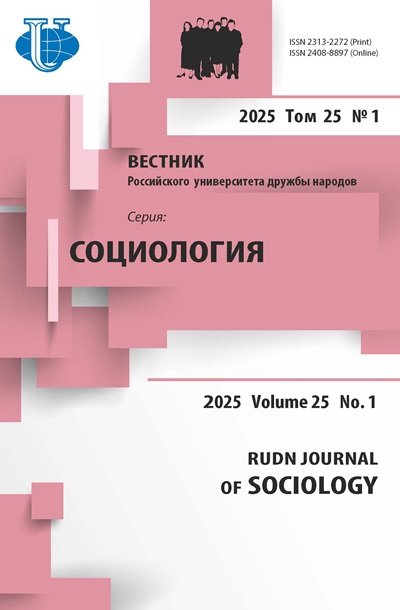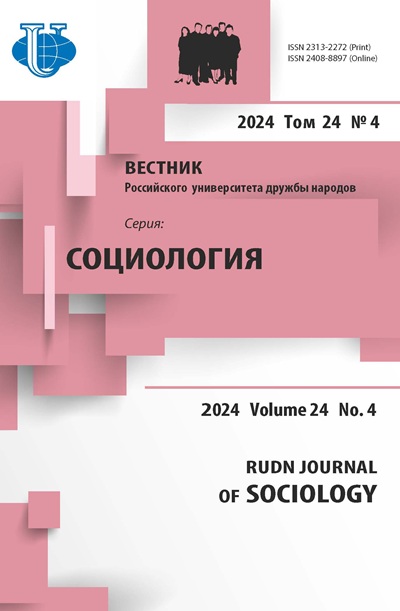Network youth communities in the social-cultural space of the northern region: methodological and empirical aspects of the study
- Authors: Chizhova L.A.1, Tutygin A.G.1, Stirmanova R.S.2
-
Affiliations:
- N. Laverov Federal Center for Integrated Arctic Research of the Ural Branch of RAS
- Lomonosov Northern (Arctic) Federal University
- Issue: Vol 24, No 4 (2024)
- Pages: 1033-1051
- Section: Contemporary society: the urgent issues and prospects for development
- URL: https://journals.rudn.ru/sociology/article/view/42235
- DOI: https://doi.org/10.22363/2313-2272-2024-24-4-1033-1051
- EDN: https://elibrary.ru/PWICFT
Cite item
Full Text
Abstract
Transformations in the contemporary society and social-cultural space have significantly changed social activity and decision-making based on retrospective attitudes, which is especially evident in the behavior of local groups of youth communities in the online space. In this study, the authors proceeded from the fact that local youth communities in northern regions (like Arkhangelsk) have unique territorial and mental features. The conducted analysis of environmental and musical (cultural) communities in the most popular social network in Russia “Vkontakte” allowed to identify a number of characteristics for the subsequent study of the conformal (threshold) behavior model. Thus, P. Jaccard’s community coefficients showed that the structural characteristics of the youth environmental online communities, partly filled with protest ideas, are not critical enough and have not reached threshold limits, i.e., there is no threat of protest transition from online to offline space. As a promising model for further studies of the youth online communities, the authors propose the game-theoretical approach as the most relevant for the empirical characteristics of online social networks. The proposed and illustrated approach can be applied in the study of the behavior of online communities of different thematic focus, with different age, gender, educational and other characteristics. In the future, the authors will verify models for assessing and predicting the behavior of local groups in social networks using the example of communities in northern regions and will provide a system of cases for decision-making in the interests of developing social-political and social attitudes of the youth.
About the authors
L. A. Chizhova
N. Laverov Federal Center for Integrated Arctic Research of the Ural Branch of RAS
Author for correspondence.
Email: chijova.mila@yandex.ru
Nikolsky Prosp., 20, Arkhangelsk, 163020, Russia
A. G. Tutygin
N. Laverov Federal Center for Integrated Arctic Research of the Ural Branch of RAS
Email: andgt64@yandex.ru
Nikolsky Prosp., 20, Arkhangelsk, 163020, Russia
R. S. Stirmanova
Lomonosov Northern (Arctic) Federal University
Email: r.s.stirmanova@gmail.com
Nab. Severnoj Dviny, 17, Arkhangelsk, 163002, Russia
References
- Batov A.V., Breer V.V., Novikov D.A., Rogatkin A.D. Mikro- i makromodeli sotsialnyh setej. Ch. 2. Identifikatiya i imitatsionnye eksperimenty [Micro and macro models of social networks. Part 2. Identification and simulation experiments]. Problemy Upravleniya. 2014; 6. (In Russ.).
- Berdnikova E.N., Ryzhenkova N.A. Dinamika razvitiya neformalnyh molodezhnyh ob`edinenij v sotsialnoj seti “VKontakte” [Dynamics of the development of informal youth associations in the VKontakte social network]. Trudy Instituta Biznes-Kommunikatsij. 2017; 1. (In Russ.).
- Blinova O.A., Gorbunova Y.A. Strategii politicheskoj kommunikatsii molodezhi v tsifrovom prostranstve: vozmozhnye iskhody [Strategies for political communication of the youth in the digital space: Possible outcomes]. Voprosy Upravleniya. 2021; 3. (In Russ.).
- Blynskaya T.A., Malinina K.O. Analiz motivatsii pokoleniya Z k osoznannomu vyboru zhiznennoj strategii (na primere g. Arkhangelska) [Analysis of the generation Z motivation to make a conscious choice of life strategy (on the example of Arkhangelsk)]. Alma Mater. 2020; 10. (In Russ.).
- Breer V.V. Teoretiko-igrovaya model neanonimnogo porogovogo konformnogo povedeniya [A game-theoretic model of non-anonymous threshold conformal behavior]. Upravlenie Bolshimi Sistemami. 2010; 31. (In Russ.).
- Breer V.V. Teoretiko-igrovye modeli konformnogo kollektivnogo povedeniya [Game-theoretic models of conformal collective behavior]. Avtomatika i Telemekhanika. 2012; 10. (In Russ.).
- Breer V.V., Novikov D.A., Rogatkin A.D. Mikro- i makromodeli sotsialnyh setej. Ch. 1. Osnovy teorii [Micro- and macro-models of social networks. Part 1. Basics of theory]. Problemy Upravleniya. 2014; 5. (In Russ.).
- Breer V.V. Modeli konformnogo povedeniya Ch. 2. Matematicheskie modeli [Models of conformal behavior. Part 2. Mathematical models]. Problemy Upravleniya. 2014; 2. (In Russ.).
- Breer V.V., Rogatkin A.D. Veroyatnostnaya model porogovogo povedeniya v mnogoagentnyh sistemah [Probabilistic model of threshold behavior in multi-agent systems]. Avtomatika i Telemekhanika. 2015; 8. (In Russ.).
- Golub O.V., Lysenko E.S. Sotsialno-psikhologicheskie osobennosti molodykh lyudej-polzovatelej sotsialnyh setej [Social-psychological features of young social networks users]. Poisk. 2018; 1 (8). (In Russ.).
- Gromov D.V. “Moralnaya panica” kak mekhanizm razvitiya ryada molodezhnyh soobshchestv Sovetskogo Soyuza i Rossii [“Moral panic” as a mechanism for the development of some youth communities in the Soviet Union and Russia]. Istoricheskaya Psikhologiya i Sotsiologiya Istorii. 2012; 1. (In Russ.).
- Davydov A.V., Koryakovtseva O.A. Molodezhnye organizatsii i dvizheniya v Rossii: istoriya i sovremennost’ [Youth organizations and movements in Russia: History and the present time]. PolitBook. 2014; 3. (In Russ.).
- Zelenina E.V., Poretskaya T.Yu. Mediakultura molodezhnyh internet-soobshchestv [Media culture of the youth online communities]. Vestnik Volzhskogo Universiteta im. V.N. Tatishcheva. 2018; 2 (2). (In Russ.).
- Kurbatov V.I., Volkov Yu.G., Vodenko K.V. Molodezhnaya subkultura v setevyh soobshchestvah: prioritety molodezhi v sotsialnyh setyah i transformatsiya sotsialno-informatsionnogo povedeniya [Youth subculture in online communities: Priorities of the youth in social networks and transformation of social-informational behavior]. Gumanitarnye, Sotsialno-Ekonomicheskie i Obshchestvennye Nauki. 2019; 10. (In Russ.).
- Lenkov R.V., Kolosova O.A., Kovaleva S.V. Sotsialno-psikhologicheskaya diagnostika i prognozirovanie protestnogo povedeniya molodezhi v tsifrovoj srede [Social-psychological diagnostics and forecasting of the youth protest behavior in the digital space]. Tsifrovaya Sotsiologiya. 2021; 4 (1). (In Russ.).
- Markin V.V., Silin A.N., Voronov V.V. Obrazovatelnye traektorii molodezhi korennyh malochislennyh narodov Severa: sotsialno-prostranstvenny diskurs [Educational trajectories of the youth of the northern indigenous peoples: A social-spatial discourse]. Ekonomicheskie i Sotsialnye Peremeny: Fakty, Tendentsii, Prognoz. 2019; 12 (5). (In Russ.).
- Musatov D.V., Savvateev A.V., Melikov S.G., Davydov D.V. Teoriya i empirika sotsialnyh Internet-setej i ih ekonomicheskie prilozheniya [Theory and empirics of social Internet networks and their economic applications]. Ekonomicheskaya Nauka Sovremennoj Rossii. 2015; 2. (In Russ.).
- Nedoseka E.V., Sharova E.N. Osobennosti zhiznennyh strategij molodezhi v usloviyah Arktiki [Features of the youth life strategies in the Arctic]. Monitoring Obshchestvennogo Mneniya: Ekonomicheskie i Sotsialnye Peremeny. 2020; 3. (In Russ.).
- Nugrokho Ya., Saritas O. Uvidet i osoznat nevidimoe. Skanirovanie, setevoj i stsenarny analiz [To see and understand the invisible. Scanning, network and scenario analysis]. Foresight. 2011; 5 (3). (In Russ.).
- Podoplekin A.O. Gorodskaya molodezh evropejskogo sektora AZRF: povedenie v informatsionnom prostranstve, tsennosti i politicheskie orientatsii v 2021–2022 godah (na primere Pomoriya) [Urban youth of the European sector of the Russian Arctic: Behavior in the information space, values and political orientations in 2021–2022 (on the example of Pomorye)]. Rossiya: Obshchestvo, Politika, Istoriya. 2023; 2 (7). (In Russ.).
- Raygorodsky A.M. Modeli sluchajnyh grafov i ih primeneniya [Random graph models and their applications]. Trudy MFTI. 2010; 2 (4). (In Russ.).
- Smirnov S.A. Forsajt: ot prognoza k sotsialnoj inzhenerii [Foresight: From forecasting to social engineering]. Vestnik NGUEU. 2014; 3. (In Russ.).
- Sotsiokulturnoe prostranstvo arkticheskogo makroregiona Rossii v sovremennyh ekonomicheskih usloviyah [Social-Cultural Space of Russia’s Arctic Macro-Region in Contemporary Economic Conditions]. Arkhangelsk; 2023. (In Russ.).
- Tutygin A.G., Chizhova L.A., Regeta A.I. Maly biznes v Arktike: predposylki dlya smeny paradigmy upravleniya [Small business in the Arctic: Prerequisites for changing the management paradigm]. Arktika i Sever. 2020; 39. (In Russ.).
- Fitisova A.V. Problema fundamentalnoj kontseptualizatsii sotsialnoj svyazi v issledovaniyah M. Granovettera [Fundamental conceptualization of social communication in M. Granovetter’s research]. Universum: Obshchestvennye Nauki. 2017; 11. (In Russ.).
- Chernysheva N.S., Andreeva A.S., Kuziner E.N. Pereosmyslyaya lokalnye identichnosti na Russkom Severe: molodezh v poiskah chistoty [Rethinking local identities in the Russian North: Youth in search of purity]. Sotsiologicheskie Issledovaniya. 2023; 12. (In Russ.).
- Albert R., Jeong H., Barabasi L.-A. Diameter of the world-wide web. Nature. 1999; 401.
- Backstrom L., Boldi P., Rosa M., Ugander J., Vigna S. Four degrees of separation. Proceedings of the 4th ACM International Conference; 2012.
- Barnes J.A. Class and committees in a Norwegian island parish. Human Relations. 1954; 7 (8).
- Barabasi L.-A., Albert R. Emergence of scaling in random networks. Science. 1999; 286.
- Barabasi L.-A., Albert R., Jeong H. Scale-free characteristics of random networks: The topology of the world-wide web. Physica A: Statistical Mechanics and its Applications. 2000; 281.
- Bollobás B., Erdős P. Cliques in random graphs. Mathematical Proceedings of the Cambridge Philosophical Society. 1976; 80.
- Bollobás B. Random Graphs. Cambridge University Press; 2001.
- Borgs C., Chayes J., Ding J., Lucier B. Hitchhiker’s guide to affiliation networks: A game-theoretic approach. Proceedings of the ICS; 2011.
- Cheng A. Six Degrees of Separation. Twitter Style; 2010.
- Erdős P., Rényi A. On random graphs. Publicationes Mathematicae. 1959; 6.
- Granovetter M. The strength of weak ties. American Journal of Sociology. 1973; 78 (6).
- Granovetter M. Threshold models of collective behavior. American Journal of Sociology. 1978; 83 (6).
- Hedström P., Sandell R., Stern C. Mesolevel networks and the diffusion of social movements: The case of the Swedish Social Democratic Party. American Journal of Sociology. 2000; 106 (1).
- Jaccard P. Distribution de la flore alpine dans le Bassin des Dranses et dans quelques regions voisines. Bulletin de la Societe Vaudoise des Sciences Naturelles. 1901; 37.
- Leskovec J., Horvitz E. Worldwide buzz: Planetary-scale views on an instant-messaging network. Proceedings of the 17th International Conference on World Wide Web. Beijing; 2008.
- Milgram S. The small world problem. Psychology Today. 1967; 1 (1).
- Scott J. Social Network Analysis: A Handbook. London; 2000.
- Tutygin A.G., Chizhova L.A. Local-group behavior of the business community and the institutional environment of the region. Journal of Environmental Treatment Techniques. 2020; 8 (1).
- Watts D., Strogatz S. Collective dynamics of “small-world” networks. Nature. 1998; 393.
- Watts D. Six Degrees: The Science of a Connected Age. New York; 2004.
- Zhang J. Tipping and residential segregation: A unified Schelling model. IZA Discussion Papers; 2009.















